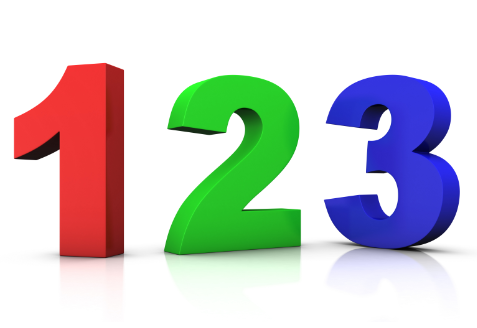Click on a concept below to try a sample question
Free, Printable Math
Worksheets for at-home Practice

Download this informative guide to learn how to best support your seventh grader as they learn and master important seventh grade math concepts.
Download Now 25+ Free Practice Worksheet questionsClick on a concept below to try a sample question
A stated objective of Common Core State Standards (CCSS) is to standardize academic guidelines nationwide. In other words, what Seventh Graders learn in math in one state should be the same as what students of the same age are learning in another state. The curricula may vary between these two states, but the general concepts behind them are similar. This approach is intended to replace wildly differing guidelines among different states, thus eliminating (in theory) inconsistent test scores and other metrics that gauge student success.
An increased focus on math would seem to include a wider variety of topics and concepts being taught at every grade level, including Seventh Grade. However, CCSS actually calls for fewer topics at each grade level. The Common Core approach (which is clearly influenced by “Singapore Math”—an educational initiative that promotes mastery instead of memorization) goes against many state standards. Many states mandate a “mile-wide, inch-deep” curriculum in which children are taught so much in a relatively short time span, that they aren’t effectively becoming proficient in the concepts they truly need to understand to succeed at the next level. Hence, CCSS works to establish an incredibly thorough foundation not only for the math concepts in future grades, but also toward practical application for a lifetime.

In Seventh Grade, CCSS recommends that instructional time should focus on four critical skills. Thinkster worksheets for seventh grade have been designed to cater to these skills:
Seventh grade is very much a transition year for math. Much will be expected this year from students—after all, this is middle school, and the level of instruction, as well as the level of expectations, has increased. Yet, seventh graders will also discover that their hard work in previous years has left them well-prepared for this year’s math. For example, the concepts of ratio and unit rates introduced in seventh grade evolve into calculating the constant of proportionality in tables, graphs, equations, and diagrams in seventh. Here are four critical areas of focus, straight from Common Core, that will be emphasized in seventh grade:
 Proportional Relationships
Proportional Relationships
As already stated, ratios and proportions are a fluency requirement for seventh grade. Some of the focus will include real-world situations such as tax, discounts, tips, and other percentage problems. Students will solve problems about scale drawings, will graph proportional relationships and learn about slope, and distinguish proportional relationships from other relationships.
 Rational Numbers, Expressions and Linear Equations
Rational Numbers, Expressions and Linear Equations
Students will understand that fractions, decimals, and percentages are different representations of rational numbers. Furthermore, they will extend their mastery of the four basic operations (addition, subtraction, multiplication, and division) to rational and negative numbers as well as expressions and equations involving one variable.
 Scale Drawings, Informal Geometric Constructions, and Cross
Sections of Twoand Three-Dimensional Shapes
Scale Drawings, Informal Geometric Constructions, and Cross
Sections of Twoand Three-Dimensional Shapes
Seventh graders will continue to work with area, including circumference and the surface area of three-dimensional objects. Congruence and similarity are on the horizon in Grade 8, and to prepare for that, students will reason about relationships using scale drawings and informal geometric constructions, as well as the relationship between angles and intersecting lines. They will also work with three-dimensional figures by examining two-dimensional cross sections, and they will solve real-world problems involving area, surface area, and volume.
 Drawing Inferences on Populations Based on Samples
Drawing Inferences on Populations Based on Samples
Having previously worked on single data distributions in Sixth Grade, seventh graders will compare two data distributions and answer questions about the differences of the populations. Also, they informally will work with random sampling to generate data sets and learn about drawing inferences based on representative samples.

Though they may have seem detailed, the four areas of focus presented in the previous section are more just starting points of what seventh graders can expect during this crucial school year. From those areas, teachers and students will delve into more specific concepts that will prepare kids for eighth grade math and beyond. The five topics presented here, taken directly from CCSS 4 itself, include some details on what kids will be taught in seventh grade.

 Ratios and Proportional Relationships
Ratios and Proportional Relationships
• Analyze proportional relationships and use them to solve realworld and mathematical problems. By the end of seventh grade, students will become experts in ratios and proportions. The concepts and activities in store for them include:
Seventh Grade: Introduction, Common Core State Standards Initiative.
 The Number System
The Number System
• Apply and extend previous understandings of operations with fractions. Rational numbers also are emphasized with this topic, and students will understand how the additive property intertwines with this concept. Some areas taught include:


 Expressions and Equations
Expressions and Equations
• Use properties of equations to generate equivalent expressions. Students will apply properties of operations to add, subtract, factor, and expand linear expressions with rational coefficients. Also, they will discover that rewriting an expression or equation in a different form (for example, x + 0.1 = 1.1x is the same as increasing a number by 10 percent and is the same as multiplying by 1.1) can lead them to a better understanding of the problem at hand
• Solve real-life mathematical problems using numeric and algebraic expressions and equations. The algebra continues. Seventh graders will learn to:
 Geometry
Geometry
• Draw, construct, and describe geometrical figures and describe the relationship between them. Students will solve problems involving scale drawings of geometric figures, will draw geometric shapes (by hand, with a ruler and compass, and with technology) with given conditions, and will describe two-dimensional figures resulting from slicing three-dimensional figures such as pyramids and rectangular prisms.
• Solve real-life and mathematical problems involving angle measure, area, surface, and volume. Seventh graders will master the formulas for area and circumference of circles and use this knowledge to solve problems. They will also work with different types of angles (supplementary, complementary, vertical, and adjacent) and solve problems involving volume and surface area of two- and three-dimensional objects composed of triangles, quadrilaterals, polygons, cubes, and right prisms.


 Statistics and Probability
Statistics and Probability
• Use random sampling to draw inferences about a population. Students will understand that statistics can be used to gain information about a population, and they will also be taught about random sampling. Furthermore, seventh graders will gather data from a random sample to draw inferences about a population with an unknown characteristic. For example, if a classroom has three more girls than boys in it, make an estimate about how many more girls are at the entire school.
• Draw informal comparative inferences about two populations. Simply put, students compare two groups and arrive at conclusions, including inferences based on variability. For example, if one cross country team averages 9-minute miles during practice and a second team averages 10-minute miles, what will happen if a runner logging 7-minute miles switches from the first team to the second?
• Investigate chance processes, and develop, use, and evaluate probability models. Though it may not appear so at first glance, probability nicely ties in to many other topics seventh graders are being taught. Among the concepts explored:
 Surviving Middle School Math
Surviving Middle School Math
Junior high is a crazy time for many students. Many self-contained middle schools (schools that aren’t K-8) present unique challenges academically and socially. The homework load is greater, the routines are completely different, and kids that seemed so young just a couple years earlier are now ... teenagers. Moreover, 67 percent of middle school teachers feel that math is the toughest subject for students to re-engage in after summer break, and 50 percent added that kids' math skills regress more than any other school subject. Combining these factors creates a situation daunting for students and parents alike. And perhaps nowhere is the challenge more acute than with middle school math. However, there’s no reason why students can’t thrive during these two critical years. What follows are several tips for middle schoolers and their parents to help them through this part of their math education.


 Middle School Study Tips
Middle School Study Tips
• Be cool If you have been looking through this guide at the topics you can expect to learn for this school year, you may be understandably intimidated. However, the way Common Core is designed, you will get plenty of instruction, practice, and reinforcement with one concept before moving on.
Furthermore, you will discover that becoming good at a certain topic sets you up to succeed at the next. In many previous math curricula, teachers would move onto the next concept before many students felt they had mastered the last one. With Common Core, you can be confident you’ll be ready for whatever lies ahead.
• Practice When You Are Not Tired The homework loads of many students increase in middle school. However, your math capabilities are better suited for when you are most alert and less tired. Therefore, try to work on math homework in the later afternoon or early evening when you are at your freshest after school. Getting all your homework completed is important, but reading a book for a literature class won’t require the computing power from your brain that math will.
• Read the Question You might encounter math problems that appear intimidating, both on first glance and after you’ve read the question. No need to worry: Almost everything being thrown at you is stuff you have learned or are currently learning. Clear your mind and read the question again. Break down the problem by writing all the given information and relevant numbers. From there, work your way through the question on your path to the answer. Once you master this process, all those intimidating problems won’t seem so frightening.
• Check Your Work One helpful aspect of solving algebraic equations is that checking your work is easy: Simply plug in the answer into the variable of the original problem and do the math. This is a good habit to start with your homework because if you made a mistake, you have time to figure out what went wrong, which will help you all the more in the future. Furthermore, once you are proficient in checking your work accurately and quickly with your homework, you will naturally do the same on tests, possibly (and hopefully!) resulting in better grades because you are catching your mistakes before handing the test in.
• Keywords, Keywords, Keywords! One math strategy you likely learned in elementary school is to look for keywords when solving word problems. Keywords are simply clues within a word problem that guide you toward a solution. This strategy is just as applicable in middle school as it was when you were younger, maybe even more so as you work to solve multi-step problems. Moreover, with new concepts you are learning, a new set of words will be entering your math vocabulary. Look for terms such as save, rate, per, proportion, percentage, and compare in middle school word problems.
• Skip the Calculator You will encounter plenty of math in the coming years (especially in trigonometry and pre-calculus) that will require the use of a calculator. At this level, however, you should know how to perform almost every required operation without technological help. Skipping the calculator and figuring out problems by hand (for example, computing circumference by multiplying by 3.14) keeps your skills sharp, shows the teacher you are taking time to solve problems instead of taking a shortcut, and prepares you for tests on which a calculator isn't allowed.
• Math Everywhere Much of the math you are learning now can extend to rest of your life. Look for opportunities to practice your skills outside of school. For example, if you are watching a football game and see that a quarterback has completed 15 of 24 passes, try converting that number to a fraction and a percentage. Or, figure out what percentage a $5 tip on a $27 haircut is. Your math skills will help your realworld skills that when sharp, will improve your in-school math skills in turn.
• Ask for Help If you find yourself struggling with a specific concept or with math in general, by all means, seek help from your teacher. Educators want you to succeed, and they will do whatever they can to help you do so … but sometimes, you have to ask. Also, don’t be afraid to tell your parents that you are having a rough time. Most adults remember how challenging middle school math was, and your parents can provide encouragement, work with you and your teacher, or explore other options to get the help you need to succeed.
 Parent Tips
Parent Tips
Parenting a 12, 13, or 14 year old is already quite a task. Navigating middle school math only increases the challenge, as well as your possible level of stress. Arguing with your child about school work is counterproductive, so staying calm and working positively with him or her is essential, no matter how frustrated you may get. The time parents get with their growing children is short enough; you don’t want to spend the middle school years in a constant battle with your kids. Take a deep breath—you will survive math during these years. Here are some tips to keep your sanity along the way:
• Be cool This is sage advice for parents as well as students. The level of math education you and your child encounter in middle school is unlike anything you may have experienced before. Yet, students this age are ready to take their learning to another level the curricula wouldn’t include such content if they weren’t capable. Though there may be bumps along the way, your child can still reach the destination.

• Relearn the Math One reason parents are apprehensive to engage their middle schooler with his or her math homework is that they might be a few decades removed from the math itself. Most parents remember how to multiply, but they might not have a clue how to solve two variable inequalities. Middle school math isn’t so difficult that adults can’t relearn the concepts. Many websites are available that describe a variety of math topics, or if you can sneak in 20 minutes here and there, read your student’s textbook (just don’t let your kids catch you!). Once you understand the math a little more, you will be better able to help your child when he or she is struggling.
• Understand Common Core Irrespective of your opinions about Common Core, more than likely, your kids are learning in a curriculum following the standards. Therefore, understanding the goals, guidelines, and structure of CCSS ultimately will help as you support your middle schooler through these years of math. For example, your child may be learning methods and strategies to solve a problem that you have never encountered. Your first inclination might be to dismiss these approaches and not offer any support. However, knowing that Common Core aims to provide multiple methods so that students achieve a well-rounded mastery will give you clarity on why your child is learning something a certain way … and it may inspire you to learn this new strategy as well.
• Drill for Skills Find opportunities for your middle schooler to practice math outside of his or her schoolwork. Challenge your daughter to compute tips. Direct your son to figure out what percentage of a gallon of gas is tax (the tax price is usually on the pump). If you are stuck in traffic or driving to an afterschool activity, rapid-fire some problems and equations, such as converting fractions to decimals. A couple extra minutes here and there keeps kids’ minds actively focused on math skills, which will be sharpened for when they are testing or doing homework.
• Become Involved If you are concerned with how Common Core is being implemented at your school, the amount of homework being given, or anything else in the math classroom, then you should absolutely get involved. Talk to teachers and administrators. Attend committee meetings. Research the subject that has you concerned. Parents naturally will have opinions about the quality of their children’s education. Those opinions can affect dialogue and solutions, but only if you take action. Your middle schooler is working hard to get the best education possible. There’s no reason you shouldn’t do the same for your child.
• Seek Help for Your Child If your middle-schooler is consistently struggling with math, your first step should be to talk to his or her teacher, who can provide guidance on how those struggles can be overcome. From there, another step you might consider is finding outside help your child. Several online resources provide math tutelage, including worksheets and sample tests that conform to Common Core standards. Tutoring might be an option, too. Innovative iPad-based math software has emerged that combines the personalized approach of a tutor with today’s technology. These revolutionary programs also may feature a curriculum based on Common Core, thus ensuring your child’s learning at home is aligned with what he or she is learning at school
In addition to the grade-specific standards it sets forth, Common Core also emphasizes eight “Standards of Mathematical Practice” that teachers at all levels are encouraged to develop in their students. Here are descriptions of these eight practices—designed to improve student performance—and how they apply to middle schoolers:

 Make sense of problems and persevere in solving them
Make sense of problems and persevere in solving them
Students explain the problem to themselves and determine ways they can reach a solution. Then, they work at the problem until it’s solved. By middle school, for example, many word problems are multi-step, requiring more than one operation on the way to an answer. Students must take care to determine what these steps are, decide what strategies (including correspondences between equations, verbal descriptions, graphs and tables, and looking for regularity and trends) will be necessary to solve the problem, and work toward the solution.
 Reason abstractly and quantitatively
Reason abstractly and quantitatively
Students decontextualize and contextualize problems. By decontextualizing, they break down the problem into anything other than the standard operation. By contextualizing, they apply math into problems that seemingly have none. Middle-schoolers who are decontextualizing may envision a fraction or decimal into unit rates—for example, a student working with the fraction 3/8 might picture three squares across a chessboard—to help solve a problem. Students who are contextualizing might break a polygon into several smaller shapes in order to compute the total area.
 Construct viable arguments and critique the reasoning of others
Construct viable arguments and critique the reasoning of others
Students use their acquired math knowledge and previous results to explain or critique their work or the work of others, analyzing and using counterexamples as necessary. Most middle-schoolers have already learned how to work with classmates to achieve a goal. Students might be encouraged not only to work with a group to solve a particularly challenging math problem, but also to present and explain their solution to the teacher and the class.
 Encourage them to show their work
Encourage them to show their work
This suggestion can be read two ways. First, students will be encouraged to show how they arrived at an answer, especially within Common Core. Second, ask your children to show you their homework, particularly the challenging stuff. Explaining how a problem is solved is a basic CCSS tenet, so if your kids can be confident in explaining their work to you, they will carry that confidence into the classroom when the teacher asks for those same explanations.
 Model with mathematics
Model with mathematics
This is just like it sounds: Students use math to solve real-world problems. For example, a national department store chain offers sales either in the form of percentages off retail price and by a flat dollar amount savings (and sometimes both). Middle-schoolers can use their knowledge of ratios and percentages to determine from which sales method they will save more.
 Use appropriate tools strategically
Use appropriate tools strategically
Another self-explanatory practice: Students learn and determine which tools are best for the math problem at hand. For older kids, the tools may seem obvious—pencil, paper, calculator, protractor, and so on—but knowing when to use what is important. For example, graph paper can be a big help when solving variable inequalities.
 Attend to precision
Attend to precision
Students strive to be exact and meticulous—period. The math vocabulary introduced to middle-schoolers rapidly expanding, so students must be precise in their words as well as their numbers. Consider this example: An equation (x=1) is different than an expression (x-1) and an inequality (x>1). Middle-schoolers who know these definitions will have an easier time when working with the corresponding concepts.
 Look for and make use of structure
Look for and make use of structure
Students will look for patterns and structures within math and apply these discoveries to subsequent problems. Take the equation x +5=10; to get an answer, 5 must be subtracted from both sides. This basic algebraic structure will apply to almost all equations middle-schoolers will encounter, no matter the operation or the number of variables. Once students recognize and master this structure, they will automatically think about both sides of the equation when solving.
 Look for and express regularity in repeated reasoning
Look for and express regularity in repeated reasoning
Students come to realizations—“aha” moments is a good term for these realizations—about the math operations that they are performing and use this knowledge in subsequent problems. For example, middle-schoolers may discover that tipping 15 percent is an easy computation: Figure out 10 percent of the bill, then take half of that and add to get 15 percent. In no time, they will want to figure out the tip when you are at a restaurant.
See up to a 90% Improvement in Math Scores Within 3 Months.
Start 7-Day Free Trial